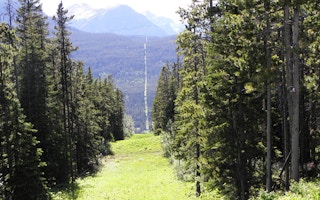Lumber prices are up more than 500 per cent in some areas, and people are even poaching trees from public forests for home projects, but this late-pandemic surge in lumber demand is a short-term threat to trees compared to the ongoing climate emergency. In some regions, temperatures are warming too fast for trees to catch up.
Because trees take decades to grow, today’s well-adapted seedlings may be unprepared for the future climate. That can have consequences far beyond the forest. Trees that are not adapted to their climate are more likely to succumb to pests and disease, and dead trees intensify forest fires. Fires lead to increased flood risks, and floods drag dust and dirt to downstream water systems, which can clog pipes and strain treatment systems.
“O’Neill and forestry researcher Erika Gómez-Pineda are coauthors of a recent article published in the Canadian Journal of Forest Research that makes the case for forestry practices to incorporate a process known as assisted population migration, in which seeds are moved to colder climates within the species’ natural range. This can help foresters capitalise on existing adaptations and bolster their forests for future climate change.
Searching for Seeds
The study addressed two seed stock questions: Where will British Columbia have problems, and where are solutions already growing in the United States? Using Representative Concentration Pathway 4.5 projections, the authors identified key parameters, including average precipitation, average temperature, and growing degree days for British Columbia’s ecosystems in the year 2055.
The study design assumes an impending planting date in 2040 and accounts for the first years of growth when trees are most susceptible to stress. Out of 207 seed zones, 44 (about 21 per cent) were at high or moderate risk of losing adapted domestic seed supply by 2040, suggesting that these zones may soon lack domestic seeds worth planting.
Next, the researchers mapped areas of the Pacific Northwest and British Columbia where historical growing conditions from 1945 (the earliest era of province-wide weather records) mirrored the expected climate in 2055.
O’Neill and Gómez-Pineda found that a matching climate area greater than 20,000 square kilometres existed in the United States for 42 of British Columbia’s 44 at-risk seed zones—that’s an area about twice the size of Puerto Rico. Even considering lakes, slopes, and neighbourhoods that would reduce the feasible seed access area, that’s still a large region where Canadian foresters could secure heartier seeds.
However, when assessing the possibility of putting assisted migration practices into place, it is important to keep phenology in mind, said Csaba Mátyás, a professor emeritus of forestry at the University of Sopron in Hungary who was not involved in the study.
Trees, Mátyás said, develop a “physiological clock” that assesses climate patterns to guide growth. Generations of trees can gradually adjust that timing, but “these horrible changes we are expecting will happen in 50–100 years, which is one generation,” Mátyás said. “You cannot rely on natural processes because [they’re] too slow.”
Mátyás noted that planning is important and seeds adapted for the future may struggle at the time of planting. Local seeds that enter artificial plantations will naturally outcompete transferred seeds. “You should be quite careful in the first 10–20 years,” he cautioned. Planting for the future works only if seedlings survive the present.
Adaptive Capacity and Culture Change
Assisted population migration is already in practice in some places. British Columbia, which plants around 300 million trees each year and exports a significant share of US lumber sales, switched from local seed selection to climate-based selection in 2018. Ontario followed in 2020. What’s more, the US Forest Service launched the Seedlot Selection Tool in 2009 to guide planting decisions.
However, borders complicate the seed-sharing process, and barriers persist. States like California have botanical border patrols, which keep out unwanted pests but complicate seed sharing. In most areas, local seeds are more convenient to access.
“It’s a complicated set of fragmented laws that determines when a species can be transported or planted,” said Alejandro Camacho, an environmental law professor at the University of California, Irvine.
But forests are traditionally managed to increase yield, which lessens resistance to population migration. “National forests generally have more built-in legal adaptive capacity than other public lands,” Camacho said. But those rules, he noted, don’t ensure the promotion of ecological health.
O’Neill believes that forestry needs a culture shift to face climate change. “We’re not in the habit of doing this,” he said of migrating seeds from other jurisdictions. “Climate change and these environmental problems don’t respect borders. If we don’t pay attention to the climate in selecting seed sources for reforestation, then we have serious problems ahead of us.”
This story was published with permission from Eos.










